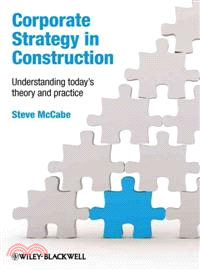Corporate Strategy In Construction - Understandingtoday'S Theory And Practice Theory And
商品資訊
ISBN13:9781405159128
出版社:John Wiley & Sons Inc
作者:Mccabe
出版日:2010/03/16
裝訂/頁數:平裝/336頁
商品簡介
作者簡介
目次
相關商品
商品簡介
This book draws together the main elements of strategic management theory and considers their relevance to contemporary practice in construction. It helps students understand what corporate strategy involves and how it is possible to develop a proactive approach to the management of key organisational resources that are essential to attain objectives.
Understanding of the importance of strategic management has developed rapidly in the past decade. Recent economic events have shown that all organisations must continually reassess their approach to achieving intended objectives, especially improvement in customer focus. The construction industry is no different. Construction employers require graduates who are competent in understanding the basis of strategic management, the range of techniques that will enable the organisation to identify opportunities and threats and respond to rapid change.
This book provides an overview of the context in which construction projects are carried out, and the potential methods that exist to conduct strategic analysis and decision-making. By analysing case studies, Corporate Strategy in Construction: Understanding today's theory & practice demonstrates how vital lessons can be learnt from other industries by benchmarking practices and developing alternative ways of delivering value to clients.
A key message of the book is that construction organisations can, with a better appreciation of strategic management, increase their potential to innovate and create sustainable competitive advantage.
Understanding of the importance of strategic management has developed rapidly in the past decade. Recent economic events have shown that all organisations must continually reassess their approach to achieving intended objectives, especially improvement in customer focus. The construction industry is no different. Construction employers require graduates who are competent in understanding the basis of strategic management, the range of techniques that will enable the organisation to identify opportunities and threats and respond to rapid change.
This book provides an overview of the context in which construction projects are carried out, and the potential methods that exist to conduct strategic analysis and decision-making. By analysing case studies, Corporate Strategy in Construction: Understanding today's theory & practice demonstrates how vital lessons can be learnt from other industries by benchmarking practices and developing alternative ways of delivering value to clients.
A key message of the book is that construction organisations can, with a better appreciation of strategic management, increase their potential to innovate and create sustainable competitive advantage.
作者簡介
Steven McCabe, Senior Lecturer in construction management, University of Central England
目次
Foreword
Preface
About the Author
Acknowledgements
Dedication
Chapter 1 Introduction
1.1 Trying to predict the future – a task fraught with risk
1.2 A journey towards strategy: art or science?
1.3 Strategy, a problem of expectation?
1.4 The dilemmas of a formal definition of strategy
1.5 The context of construction – a truly unique industry?
1.6 Developing an understanding of who ‘consumes’ construction
1.7 The structure of this book
Chapter 2 Strategic management theory: its origins, development and relevance to contemporary organisations
2.1 Objectives of this chapter
2.2 Early origins
2.3 The rise and rise of strategy as a corporate tool
2.4 So what are the main concepts of strategy – back to the problems of definition?
2.5 Mintzberg’s ‘Five Ps’ conceptualisation of strategy
2.6 The hierarchy of strategy
2.7 Terms associated with strategy
2.8 Attaining success: the importance of analysis, development and implementation
2.9 The three essentials of strategic decision-making
2.10 Lynch’s text of ‘good’ strategy
2.11 What will really work? An exploration of major theoretical perspectives
2.12 The relevance of strategic theory and some considerations of Whittington’s generic perspective
2.13 Conclusion
Chapter 3 A short socio-historical analysis of the development of the British construction industry
3.1 Objectives of this chapter
3.2 Early origins – the beginnings of civilisation
3.3 The Roman influence
3.4 Medieval organisation – the emergence of the guild system
3.5 The malign influence of merchants
3.6 The end of artisans and the emergence of alternative arrangements
3.7 Contracting and its long-term effects on people, processes and production
3.8 The rise and fall of trade unionism in construction
3.9 The National Building Strike and its long-term consequences
3.10 Time for change?
3.11 Government intervention – the impact of the ‘Latham’ and Rethinking Construction reports
3.12 So where is construction currently and what is next?
3.13 Conclusion
Chapter 4 Understanding the environment – markets and competition
4.1 Objectives of this chapter
4.2 Appreciating the context of construction
4.3 How are markets considered?
4.4 Appreciating the dynamics of markets and competition
4.5 Overall analysis of the environment
4.6 What are the dynamics of competition? 71
4.7 Analysing competitive behaviour – a consideration of adaptive strategy
4.8 How do markets grow?
4.9 Competitive advantage
4.10 Conclusion
Chapter 5 Strategy and its connection with consumers and customers – the keys to success
5.1 Objectives of this chapter
5.2 Defining consumers and customers
5.3 Customers – who are they and what do they want?
5.4 The use of ‘customer-profiling’
5.5 Customer–competitor matrix
5.6 Importance–performance analysis
5.7 Market segmentation
5.8 Revisiting Miles and Snow’s analytical model of competitive behaviour
5.9 Using the BCG matrix to analyse customers
5.10 The McKinsey Directional Policy Matrix
5.11 Considering the value of these matrices
5.12 Making connections with consumers – the importance of communication and feedback
5.13 The emergence of the concept of customer as ‘king’ – what the Japanese taught the west and how it has been developed
5.14 Conclusion
Chapter 6 Developing and maintaining organisational resources – the basis for delivering strategy
6.1 Objectives of this chapter
6.2 Resource usage – an overview
6.3 A contemporary consideration of how organisations use resources
6.4 The objective of adding value to resources
6.5 How resources are valued – applying ‘economic rent’
6.6 How organisations develop capability based on their resources –an appreciation of the importance of the resource-based perspective (RBV)
6.7 Resources and their place in the structure
6.8 Using VRIO framework to decide on resource application
6.9 The importance of resources, distinctive capability and core competences
6.10 Developing an understanding of people, productive capability and finance
6.11 Using integration as a tactic to obtain resources
6.12 Conclusion
Chapter 7 ‘Organisation[al] matters’ – a strategic perspective of the importance of how to manage people
7.1 Objectives of this chapter – what is organisation?
7.2 Organisation and structure – a consideration of contemporary changes in perception
7.3 Structure, processes and relationships – virtuous combinations?
7.4 Purpose and organisation
7.5 Setting objectives – the importance of mission
7.6 Organisational configuration
7.7 Leadership
7.8 Getting the best from people – the ‘secret’ of really successful organisations
7.9 The importance of organisational culture
7.10 Conclusion
Chapter 8 Knowledge, innovation and technology – the ‘keys’ to the future
8.1 Objectives of this chapter
8.2 Knowing and doing – linking them together to ensure appropriate action
8.3 The context of construction
8.4 Defining knowledge
8.5 Learning as a way of organisational life
8.6 What is innovation?
8.7 The importance of technology
8.8 Conclusion
Chapter 9 Change – the only constant in strategy
9.1 Objectives of this chapter
9.2 The theoretical basis of change management
9.3 Strategic change in organisations – deriving an understanding of what is involved
9.4 Types of strategic change
9.5 The causes of change
9.6 How to manage change
9.7 A change for the better? Challenging the assumptions of the planned approach
9.8 Emergent models of change
9.9 The role of managers in change
9.10 Strategic leadership approaches
9.11 Changing the way things are really done
9.12 Communicating change
9.13 Potential problems with change
9.14 Conclusion
Chapter 10 Considering the development of strategic options
10.1 Objectives of this chapter
10.2 What to do?
10.3 The importance of resources in making choice
10.4 Using the value chain to consider resources
10.5 Andrews and SWOT
10.6 The use of a resource-based view
10.7 The importance of core competences
10.8 Using the six criteria to judge strategy
10.9 The ADL Matrix
10.10 Who makes the decision?
10.11 Using scenarios
10.12 The importance of context
10.13 Conclusion
Chapter 11 Implementing the strategy – issues, dilemmas and delivery of strategic outcomes
11.1 Objectives of this chapter 223
11.2 Getting to the end – the difference between ‘intended’ and ‘realised’ strategy
11.3 The influence of purpose and dynamics on resources used
11.4 Planning for action
11.5 Making it happen – the influence of Kaplan and Norton
11.6 Communication and approaches
11.7 Strategic control
11.8 Dealing with failure
11.9 How to recover
11.10 Retrenchment strategies
11.11 Turnaround strategies
11.12 Managing in recession and decline
11.13 What about turbulent markets?
11.14 A general review of how to ensure that strategy remains coherent
11.15 Conclusion
Chapter 12 Turning theory into practice – some empirical examples of strategy in construction organisations
12.1 Introduction to this chapter
12.2 An overview of the contributions of strategic practice
12.3 Continual improvement in Thomas Vale as a way of life
12.4 Past, present and future – survival strategies in the face of a global downturn in construction work
12.5 ‘Specialisation vs generalisation in the construction industry –a strategic overview’: Adonis construction
12.6 Interserve
12.7 Innovation and creativity in Morgan Ashurst
12.8 As safe as houses – the importance of the NHBC
12.9 Strategic management and change in construction: ‘The Argent Perspective’
12.10 Wates Construction
12.11 Strategic collaborative framework partnerships in Birmingham Urban Design
12.12 Is it possible for a small quantity surveying consultancy to survive and thrive in an economic crisis?
12.13 Strategic management in a micro-organisation
References
Further Reading
Glossary
Index
Preface
About the Author
Acknowledgements
Dedication
Chapter 1 Introduction
1.1 Trying to predict the future – a task fraught with risk
1.2 A journey towards strategy: art or science?
1.3 Strategy, a problem of expectation?
1.4 The dilemmas of a formal definition of strategy
1.5 The context of construction – a truly unique industry?
1.6 Developing an understanding of who ‘consumes’ construction
1.7 The structure of this book
Chapter 2 Strategic management theory: its origins, development and relevance to contemporary organisations
2.1 Objectives of this chapter
2.2 Early origins
2.3 The rise and rise of strategy as a corporate tool
2.4 So what are the main concepts of strategy – back to the problems of definition?
2.5 Mintzberg’s ‘Five Ps’ conceptualisation of strategy
2.6 The hierarchy of strategy
2.7 Terms associated with strategy
2.8 Attaining success: the importance of analysis, development and implementation
2.9 The three essentials of strategic decision-making
2.10 Lynch’s text of ‘good’ strategy
2.11 What will really work? An exploration of major theoretical perspectives
2.12 The relevance of strategic theory and some considerations of Whittington’s generic perspective
2.13 Conclusion
Chapter 3 A short socio-historical analysis of the development of the British construction industry
3.1 Objectives of this chapter
3.2 Early origins – the beginnings of civilisation
3.3 The Roman influence
3.4 Medieval organisation – the emergence of the guild system
3.5 The malign influence of merchants
3.6 The end of artisans and the emergence of alternative arrangements
3.7 Contracting and its long-term effects on people, processes and production
3.8 The rise and fall of trade unionism in construction
3.9 The National Building Strike and its long-term consequences
3.10 Time for change?
3.11 Government intervention – the impact of the ‘Latham’ and Rethinking Construction reports
3.12 So where is construction currently and what is next?
3.13 Conclusion
Chapter 4 Understanding the environment – markets and competition
4.1 Objectives of this chapter
4.2 Appreciating the context of construction
4.3 How are markets considered?
4.4 Appreciating the dynamics of markets and competition
4.5 Overall analysis of the environment
4.6 What are the dynamics of competition? 71
4.7 Analysing competitive behaviour – a consideration of adaptive strategy
4.8 How do markets grow?
4.9 Competitive advantage
4.10 Conclusion
Chapter 5 Strategy and its connection with consumers and customers – the keys to success
5.1 Objectives of this chapter
5.2 Defining consumers and customers
5.3 Customers – who are they and what do they want?
5.4 The use of ‘customer-profiling’
5.5 Customer–competitor matrix
5.6 Importance–performance analysis
5.7 Market segmentation
5.8 Revisiting Miles and Snow’s analytical model of competitive behaviour
5.9 Using the BCG matrix to analyse customers
5.10 The McKinsey Directional Policy Matrix
5.11 Considering the value of these matrices
5.12 Making connections with consumers – the importance of communication and feedback
5.13 The emergence of the concept of customer as ‘king’ – what the Japanese taught the west and how it has been developed
5.14 Conclusion
Chapter 6 Developing and maintaining organisational resources – the basis for delivering strategy
6.1 Objectives of this chapter
6.2 Resource usage – an overview
6.3 A contemporary consideration of how organisations use resources
6.4 The objective of adding value to resources
6.5 How resources are valued – applying ‘economic rent’
6.6 How organisations develop capability based on their resources –an appreciation of the importance of the resource-based perspective (RBV)
6.7 Resources and their place in the structure
6.8 Using VRIO framework to decide on resource application
6.9 The importance of resources, distinctive capability and core competences
6.10 Developing an understanding of people, productive capability and finance
6.11 Using integration as a tactic to obtain resources
6.12 Conclusion
Chapter 7 ‘Organisation[al] matters’ – a strategic perspective of the importance of how to manage people
7.1 Objectives of this chapter – what is organisation?
7.2 Organisation and structure – a consideration of contemporary changes in perception
7.3 Structure, processes and relationships – virtuous combinations?
7.4 Purpose and organisation
7.5 Setting objectives – the importance of mission
7.6 Organisational configuration
7.7 Leadership
7.8 Getting the best from people – the ‘secret’ of really successful organisations
7.9 The importance of organisational culture
7.10 Conclusion
Chapter 8 Knowledge, innovation and technology – the ‘keys’ to the future
8.1 Objectives of this chapter
8.2 Knowing and doing – linking them together to ensure appropriate action
8.3 The context of construction
8.4 Defining knowledge
8.5 Learning as a way of organisational life
8.6 What is innovation?
8.7 The importance of technology
8.8 Conclusion
Chapter 9 Change – the only constant in strategy
9.1 Objectives of this chapter
9.2 The theoretical basis of change management
9.3 Strategic change in organisations – deriving an understanding of what is involved
9.4 Types of strategic change
9.5 The causes of change
9.6 How to manage change
9.7 A change for the better? Challenging the assumptions of the planned approach
9.8 Emergent models of change
9.9 The role of managers in change
9.10 Strategic leadership approaches
9.11 Changing the way things are really done
9.12 Communicating change
9.13 Potential problems with change
9.14 Conclusion
Chapter 10 Considering the development of strategic options
10.1 Objectives of this chapter
10.2 What to do?
10.3 The importance of resources in making choice
10.4 Using the value chain to consider resources
10.5 Andrews and SWOT
10.6 The use of a resource-based view
10.7 The importance of core competences
10.8 Using the six criteria to judge strategy
10.9 The ADL Matrix
10.10 Who makes the decision?
10.11 Using scenarios
10.12 The importance of context
10.13 Conclusion
Chapter 11 Implementing the strategy – issues, dilemmas and delivery of strategic outcomes
11.1 Objectives of this chapter 223
11.2 Getting to the end – the difference between ‘intended’ and ‘realised’ strategy
11.3 The influence of purpose and dynamics on resources used
11.4 Planning for action
11.5 Making it happen – the influence of Kaplan and Norton
11.6 Communication and approaches
11.7 Strategic control
11.8 Dealing with failure
11.9 How to recover
11.10 Retrenchment strategies
11.11 Turnaround strategies
11.12 Managing in recession and decline
11.13 What about turbulent markets?
11.14 A general review of how to ensure that strategy remains coherent
11.15 Conclusion
Chapter 12 Turning theory into practice – some empirical examples of strategy in construction organisations
12.1 Introduction to this chapter
12.2 An overview of the contributions of strategic practice
12.3 Continual improvement in Thomas Vale as a way of life
12.4 Past, present and future – survival strategies in the face of a global downturn in construction work
12.5 ‘Specialisation vs generalisation in the construction industry –a strategic overview’: Adonis construction
12.6 Interserve
12.7 Innovation and creativity in Morgan Ashurst
12.8 As safe as houses – the importance of the NHBC
12.9 Strategic management and change in construction: ‘The Argent Perspective’
12.10 Wates Construction
12.11 Strategic collaborative framework partnerships in Birmingham Urban Design
12.12 Is it possible for a small quantity surveying consultancy to survive and thrive in an economic crisis?
12.13 Strategic management in a micro-organisation
References
Further Reading
Glossary
Index
主題書展
更多
主題書展
更多書展今日66折
您曾經瀏覽過的商品
購物須知
外文書商品之書封,為出版社提供之樣本。實際出貨商品,以出版社所提供之現有版本為主。部份書籍,因出版社供應狀況特殊,匯率將依實際狀況做調整。
無庫存之商品,在您完成訂單程序之後,將以空運的方式為你下單調貨。為了縮短等待的時間,建議您將外文書與其他商品分開下單,以獲得最快的取貨速度,平均調貨時間為1~2個月。
為了保護您的權益,「三民網路書店」提供會員七日商品鑑賞期(收到商品為起始日)。
若要辦理退貨,請在商品鑑賞期內寄回,且商品必須是全新狀態與完整包裝(商品、附件、發票、隨貨贈品等)否則恕不接受退貨。
























